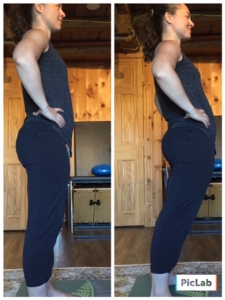When we hear the word neutral we typically think of a neutral pelvis. We don’t always consider that every one of our joints has a neutral position. That includes every vertebra in the spine through the neck, the shoulders, the knees, the elbows, the wrists, and the ankles. All joints have a neutral.
Spending time neutral reduces wear and tear on the tendons and ligaments that connect all your joints.
Neutral
Luckily the body is incredibly versatile. You don’t have to exist in neutral all the time. The body is capable and, in fact, made to come out of neutral at different times for different activities and needs. That being said there is benefit to understanding when your joints are in neutral and enabling them some time to exist there. Due to tightness in our body, sometimes some of our joints rarely get to be neutral—a problem that can wreak havoc over time.
Neutral Knees
Consider your knees. If you are someone who tends to lock your knees when standing, your knees are regularly not in neutral. That locked position is going to put more pressure on the joint all day while you are standing. It is worth taking a moment and seeing what it feels like to soften the knees. It might feel funny and off balance at first. Change is never all or nothing. Simply think about the position of your knees a couple times a day and allow the body to find it’s happy place in neutral for a moment.
Neutral Shoulder
The shoulder joint is a complicated fellow. Many people struggle to find neutral in their shoulder joint. If you shoulder never exists in neutral, than every movement you make with your arm is degrading tendons, increasing wear and tear on the tendons and ligament that hold the shoulder joint together.
Neutral Ankle
If your ankles roll in (pronation) or out (supination) you might see the inside or the outside of your shoes wear away faster. What is happening to your shoes is likely happening to your ankle too and then possibly trickling up to the knee. So once in a while when standing, make note of where your ankles are in space and try to stand with them in neutral. See how that feels. Maybe if feels funny. Maybe it takes a load off.
Proprioception
Our body had a keen ability to sense itself in space—a fact we often take for granted. Think of how you rarely, if ever, fall out of bed as an adult. You know where you are even when you don’t realize it. It’s called proprioception. Sobriety tests that require you to touch your nose with your eyes closed are testing your proprioception. The central nervous system senses where our muscles, tendons, ligaments, and joint positions are to note where we are and how we are positioned.
In addition to reducing wear and tear on the joints, neutral may help of with proprioception. It might be easier to sense ourselves when we are neutral in part because neutral should be where the joint is most functional. Injured parts of the body have worse proprioception. A neutral joint should be like coming back home after a journey. We can travel and explore the world, but getting home to sleep in our own bed feels safe, comfortable, and welcoming. When we have a group of muscles overriding and tugging us in one direction, we never get to feel like we settle into home.
It is helpful to notice our position, take stock in our body, and see where, when, and if ever we exist with neutral joints in different parts of our body, not just a neutral pelvis. Not because you have to spend all your time in neutral joints, but because doing say will take a load off the body.
Keep Reading
Need help finding a neutral pelvis? Click here.
If you don’t think your ankle is neutral due to bunion pain, check out this blog.
Keep Connected
Order Your Copy of Keep Moving Today!
Subscribe to the Keep Moving Blog
Like the Personal Euphoria Facebook page
Find us on Twitter
Follow me on Instagram
Subscribe to my YouTube Channel


Thanks for sharing!